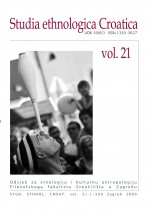Nekateri topografski vidiki obrednih mest
Some Topographic Aspects of Ritual Places
Author(s): Andrej PleterskiSubject(s): Customs / Folklore, Middle Ages, Theology and Religion, Cultural Anthropology / Ethnology
Published by: Sveučilište u Zagrebu, Filozofski fakultet
Keywords: Croatia; Slovenia; early Middleages; pre-slavic period; mythical landscape; pre-christian ideology; mythology; sacred places; archeoastronomy;
Summary/Abstract: In the introduction the author presents the ideology system that is known under the folk name old faith. This system tried to establish permanent harmony, especially between the three basic natural elements: fire (sky), earth and water. In Slovenia the name tročan still remains in use for this old faith. In accordance to the tročan principles an ideal spatial organisation consisted of three points of worship that were dedicated to the three forces of nature. Settlements, fields, burial sites, as well as the points of worship themselves were oriented towards one of these points of worship. They were accompanied by the axis mundi that supported the sky. These principles were never an canonized part of the belief, and they were taken into account to a certain degree, depending on the context. However, some solutions were often repeated and showed the core idea. During Christianisation three scenarios were likely for these points of worship: a) churches were built on them, b) they were destroyed, or c) the points of worship were moved to a new point which included a Christian church. Unchanged old belief points of worship are today found very rarely. The text deals with three examples in Croatia. In the Krasno area (North Velebit) the worshiping practice of a fertility stone was moved from the high altitude plateau Jezera into the valley, where the pilgrim’s temple of Majka Božja od Krasna (Mary, the Mother of God) was established. On the island of Pag the three points of worship have clear spatial relations. St. Marija that lies south of St. Juraj is oriented towards St. Vid. With at least a part of its architecture St. Juraj is also oriented towards St. Vid. The latter is located on the highest point of the island and makes excellent use of its astronomic position, for it is oriented towards the sunrise on St. George’s day (24th April). According to the ancient Eurasian calendar this was when the year begun. The worship system was at its strongest in the early medieval period; it is clear that St. Marija continued the point of worship tradition from late antiquity. On the high altitude plateau of Rujno (South Velebit) two points of worship step out. The rock Baba was visited by women while ‘the grave of the virgin child’ (today St. Bogorodica - Mary, the Mother of God) was visited by shepherds, i.e. men. This means that we had a stone for men and a stone for women, and they were oriented towards each other (with the male stone the orientation was later on adopted by St. Bogorodica). The Baba rock is an example of an unchanged point of worship, which with its placement in the surrounding mythological landscape undoubtedly indicates that this is the clitoris of mother earth. In Croatia all of the compounds of the tročan old belief ideology can be found. Even though only a single point was determined on Northern Velebit, and two on the Southern side, this does not mean that this is the exact and final number to be found at these locations, i.e. that these points represented the entire structure. We could thus understand this analysis merely as an encouragement for future researches. There is a great possibility that much of the mythical landscape from the pre-Slavic period survived to the present day, of course it is now full of everything the younger periods have added.
Journal: Studia ethnologica Croatica
- Issue Year: 2009
- Issue No: 21
- Page Range: 27-46
- Page Count: 20
- Language: Slovenian

